Radical equations appear in math when we take square roots, cube roots, or higher roots of expressions with variables. Solving these equations is not enough – we also need to verify the solutions we find!
So, what is a radical equation? A radical equation contains one or more variables in the radicand (under the radical symbol). If the index of the radical is n, we isolate the radical and raise both sides of the equation to the nth power to solve for the variable. Be careful about extraneous solutions from radical equations!
Of course, a radical equation can have more than one solution – it all depends on the powers of variables and the index of the radical involved.
In this article, we’ll talk about radical equations and look at some examples of how to solve them. We’ll also talk about the solutions of these equations and what to look out for.
Let’s get started.
What Is A Radical Equation?
A radical equation is an equation that has at least one radical with a variable in the radicand (under the square root symbol). For example, here are some radical equations:
- √(x – 2) = 5
- 3√(2x + 6) = 2
- √x + 3√x = 1
To identify a radical equation, just look for a radical with one or more variables under the radical symbol.
How To Solve A Radical Equation
To solve a radical equation, we can take the following steps:
- 1. Isolate the radical term on one side of the equation.
- 2. Find the index of the radical (for example, n = 2 for a square root).
- 3. Raise both sides of the equation to the power of n (the radical’s index).
- 4. Simplify (cancel radicals, FOIL, combine like terms, etc.)
- 5. Use algebra to solve the resulting equation as usual.
- 6. Test the values you find in the original equation to check your answers and to find extraneous solutions.
- 7. State the full solution, excluding extraneous solutions.
Here are some examples to make the concept clear.
Example 1: Solving A Radical Equation
Let’s look at one of the radical equations from earlier:
- √(x – 2) = 5
Step 1 is already complete, since the radical is isolated on the left side of the equation.
Step 2: Since we have a radical with no index, we assume the index to be n = 2 (a square root).
Step 3: Next, we raise both sides of the equation to the power of n = 2:
- (√(x – 2))2 = 52
Step 4: Then, we simplify the equation by canceling the radical and power of 2:
- x – 2 = 25
Step 5: Now that the radical is gone, we solve the equation as usual with algebra:
- x = 27
Step 6: Almost done, but we need to check our answer in the original equation:
- √(x – 2) = 5
- √(27 – 2) = 5
- √(25) = 5
- 5 = 5
The equation is true, so x = 27 is a solution to the original equation.
Step 7: We state our final answer: x = 27 is the single solution. We can verify this with the graph below.

Example 2: Solving A Radical Equation
Let’s look at a slightly more involved radical equation:
- √(2x – 2) + 5 = x
Step 1: we subtract 5 from both sides to isolate the radical on the left side:
- √(2x – 2) + 5 – 5 = x – 5
- √(2x – 2) = x – 5
Step 2: Since we have a radical with no index, we assume the index to be n = 2 (a square root).
Step 3: Next, we raise both sides of the equation to the power of n = 2:
- (√(2x – 2))2 = (x – 5)2
Step 4: Then, we simplify the equation by canceling the radical and power of 2, and also by using FOIL to expand the right side:
- 2x – 2 = (x – 5)2 [square root and power of 2 cancel]
- 2x – 2 = x2 – 5x – 5x + 25 [used FOIL]
- 2x – 2 = x2 – 10x + 25 [combined like terms]
Step 5: Now that the radical is gone, we solve the equation as usual with algebra:
- 2x – 2= x2 – 10x + 25
- -2 = x2 – 12x + 25
- 0 = x2 – 12x + 27
- 0 = (x – 3)(x – 9)
- x = 3 or x = 9
Step 6: Almost done, but we need to check our answers in the original equation.
For x = 3:
- √(2x – 2) + 5 = x
- √(2(3) – 2) + 5 = 3
- √(4) + 5 = 3
- 2 + 5 = 3
- 7 = 3 (?)
This equation is not true, so x = 3 is an extraneous solution (it is not a solution to the original equation – more on this later).
For x = 9:
- √(2x – 2) + 5 = x
- √(2(9) – 2) + 5 = 9
- √(16) + 5 = 9
- 4 + 5 = 9
- 9 = 9
The equation is true, so x = 9 is a solution to the original equation.
Step 7: We state our final answer: x = 9 is the single solution, since x = 3 is an extraneous solution. We can verify this with the graph below.
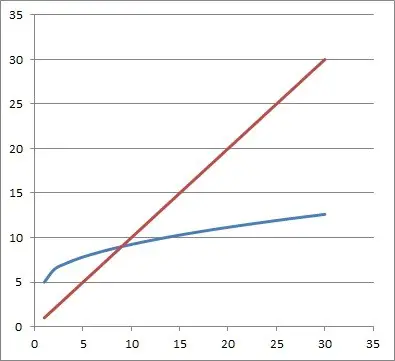
How To Solve A Radical Equation With Two Radicals
In some cases, you may need to solve a radical equation with two separate radicals. The index for one radical may be different from another, so things can get complicated.
Let’s look at a relatively simple example of a radical equation with two radicals.
Example 1: Solving A Radical Equation With Two Radicals
- √(x – 4) – √(x + 3) = 7
Step 1: we will isolate the radical term √(x – 4) on the left:
- √(x – 4) – √(x + 3) + √(x + 3) = 7 + √(x + 3)
- √(x – 4) = 7 + √(x + 3)
Step 2: Since we have a radical with no index, we assume the index to be n = 2 (a square root).
Step 3: Next, we raise both sides of the equation to the power of n = 2:
- (√(x – 4))2 = (7 + √(x + 3))2
Step 4: Then, we simplify the equation by canceling the radical and power of 2:
- x – 4 = (7 + √(x + 3))2 [square root and power of 2 cancel]
- x – 4 = 49 + 7√(x + 3) + 7√(x + 3) + (x + 3) [used FOIL]
- x – 4 = 49 + 14√(x + 3) + (x + 3) [combined like terms]
Now we need to isolate the remaining radical:
- x – 4 = 49 + 14√(x + 3) + (x + 3)
- x – 4 = 52 + 14√(x + 3) + x
- x – 56 = 14√(x + 3) + x
- -56 = 14√(x + 3)
- -4 = √(x + 3)
Now we raise both sides to the power of 2:
- (-4)2 = (√(x + 3))2
- 16 = x + 3
- 13 = x
Step 6: Almost done, but we need to check our answer in the original equation:
- √(x – 4) – √(x + 3) = 7
- √(13 – 4) – √(13 + 3) = 7
- √(9) – √(16) = 7
- 3 – 4 = 7
- -1 = 7
This equation is not true, so x = 13 is an extraneous solution (it is not a solution to the original equation).
Step 7: To state our final answer: there is no solution to this radical equation. We can verify this with the graph below.
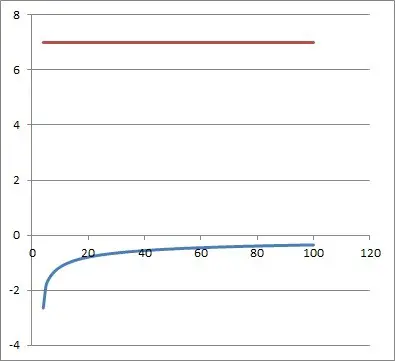
How Many Solutions Do Radical Equations Have?
The number of solutions for a radical equation depends on:
- The index of the radical
- The radicand (for example, a polynomial of higher degree means more potential solutions)
First, consider the following radical equation:
- √x = 2
It has a single solution: x = 4, due to the linear radicand (which is just “x”).
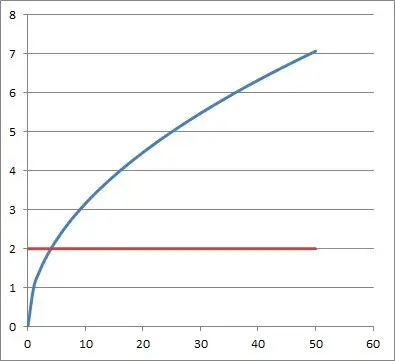
Next, consider the radical equation:
- √(x2 + 4x + 7) = 2
It has two solutions: x = -1 and x = -3, due to the quadratic radicand (which is “x2 + 4x + 7”).
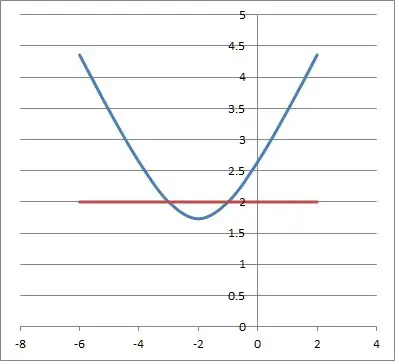
Finally, consider the radical equation:
- √(x3 + 6x2 + 11x + 15) = 3
It has three solutions: x = -1, x = -2, and x = -3, due to the quadratic radicand (which is “x3 + 6x2 + 11x + 15”).
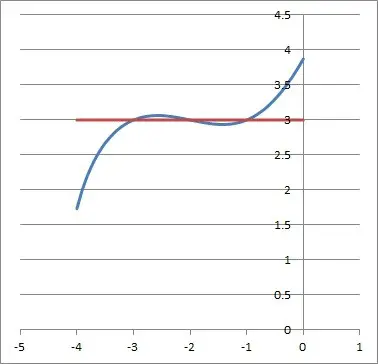
Can A Radical Equation Have No Solution?
A radical equation can have no solution in some cases. For example, the following equation (which we tried to solve earlier) has no solution:
- √(x – 4) – √(x + 3) = 7
Although we can “solve” the equation (as shown earlier), the solution we find is extraneous, meaning it does not satisfy the original equation. Instead, the solution resulted from an operation we used (such as squaring both sides of the equation).
Can A Radical Equation Have Two Solutions?
A radical can have two solutions in some cases. For example, the following equation (which we saw earlier) has two solutions:
- √(x2 + 4x + 7) = 2 [the radical is already isolated]
- (√(x2 + 4x + 7))2 = 22 [square both sides, since the index of the radical is n = 2]
- x2 + 4x + 7 = 4 [the square root and exponent of 2 cancel]
- x2 + 4x + 3 = 0
- (x + 1)(x + 3) = 0
- x = -1 or x = -3
Both of these solutions work in the original equation:
For x = -1:
- √((-1)2 + 4(-1) + 7) = 2
- √(1 – 4 + 7) = 2
- √4 = 2
- 2 = 2
This equation is true, so x = -1 is a solution.
For x = -3:
- √((-3)2 + 4(-3) + 7) = 2
- √(9 – 12 + 7) = 2
- √4 = 2
- 2 = 2
This equation is true, so x = -3 is a solution.
Thus, there are two solutions to this radical equation: x = -1 and x = -3.
What Is An Extraneous Solution To A Radical Equation?
An extraneous solution to a radical equation is a value for a variable that does not satisfy the original equation, but satisfies an equation we got from the original one.
Extraneous solutions can appear when we square both sides of an equation. For example, we know that the equation
- √x = -2
has no solution.
Note: the number x = 4 does not work here, since we always take the principal, or positive, square root of a number, and so √4 is 2, not -2.
If we want the negative root, we have to write an explicit negative sign: -√4 = -2.
However, if we square both sides of the equation, we get an extraneous solution of x = 4:
- (√x)2 = (-2)2
- x = 4
Why Are There Extraneous Solutions To A Radical Equation?
There are extraneous solutions to a radical equation because squaring both sides eliminates the negative signs that are present. If one side of the equation is positive and the other is negative, there is no solution.
However, if we start with an equation that has no solution (is false), we can square both sides to get a true equation (one that has a solution).
For example, we know that -2 = 2 is not true. However, if we square both sides of the equation, we get (-2)2 = 22 or 4 = 4, which is true.
Can A Radical Equation Have Two Extraneous Solutions?
A radical equation can have two extraneous solutions. For example, consider a radical equation we saw earlier, but with one change: the right side is negative instead of positive:
- √(x2 + 4x + 7) = -2
We know that there is no solution, since the left side is nonnegative (a square root cannot be negative) and the right side is negative. However, if we square both sides, we get:
- (√(x2 + 4x + 7))2 = (-2)2 [square both sides, since the index of the radical is n = 2]
- x2 + 4x + 7 = 4 [the square root and exponent of 2 cancel]
- x2 + 4x + 3 = 0
- (x + 1)(x + 3) = 0
- x = -1 or x = -3
However, neither of these values works in the original equation, since the left side will give a square root that is equal to +2, while the right side is -2.
Note that we can arrange for a radical equation to have 1, 2, 3, or more extraneous solutions. For example, consider another radical equation we saw earlier, again with one change: the right side is negative instead of positive:
- √(x3 + 6x2 + 11x + 15) = -3
Again, we know that there is no solution, since the left side is nonnegative and the right side is negative. However, if we square both sides and solve, we get the three extraneous solutions x = -1, x = -2, and x = -3.
Conclusion
Now you know what radical equations are and how to solve them. You also know what to look out for as far as extraneous solutions and checking your answers.
You can learn about the difference between expressions and equations here.
You can refresh your memory about when to add or multiply exponents in my article here.
You can learn about other nonlinear functions in my article here.
Learn more about square roots and other radicals in denominators (and how to rationalize them) here.
I hope you found this article helpful. If so, please share it with someone who can use the information.
Don’t forget to subscribe to my YouTube channel & get updates on new math videos!
~Jonathon


